pdilley
Well-Known Member
- Joined
- 1/3/09
- Messages
- 1,393
- Reaction score
- 31
I decided to get out the camera and take a photograph of the system I used to save some hops I was given (cheers Fraser John) that were in a bit of a state condition wise. It may help others who are having difficulty with theirs.

This is the basic setup:
o 50 litre plastic containers from Bunnings on special at $9 each. (including lids - not shown; cheaper to buy than any pot this size)
o A few large bags of good potting mix
o Compressed bale of field pea straw
o Some worm poo tea (not shown)
o Aluminium (optional - name tags)
o Bailing wire or similar (optional - bird deterrent; doves love to steal your straw for nesting material)
Mulch is the single most important thing you can do to ensure that:
o moisture is retained and transpired slowly out of the system
o sunlight does not strike the soil and carbonise off the top soil layer
o there is a carbon/humus system that can be broken down by bacteria and fungi
o weed seeds are retarded in growth (a thicker top layer of mulch required than as shown for this feature)
If I was living in a hot dry bastard of a place like Canberra, I would increase the thickness of the top mulch layer considerably, up to 30cm max thickness which would be overflowing in these containers so adjust size accordingly.
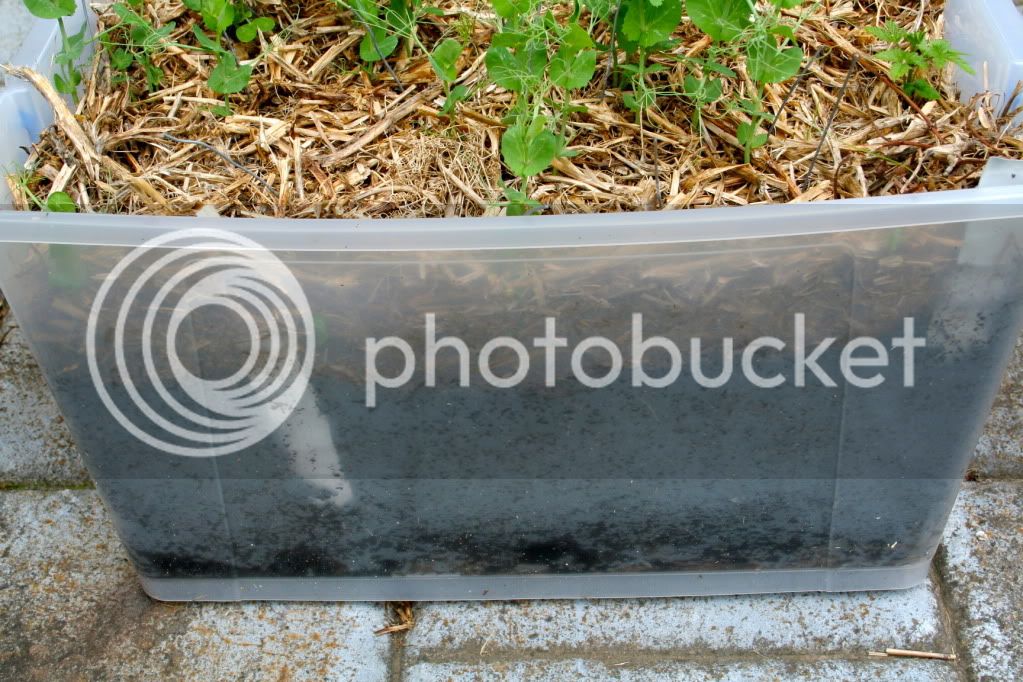
Here we see the layering going on in the containers:
o Small holes punched into the bottom of the containers for drainage (not shown)
o Layer of field pea mulch on the bottom for anaerobic bacterial breakdown cycle
o Middle layer of good potting mix to hold the rhizomes
o A very good layer of field pea straw mulch on top for aerobic bacterial and fungal breakdown cycle (any sprouting peas die and break down releasing nutrients back into the sub soil)
I have allowed the remaining field pea seeds in the top layer mulch to germinated and grow. A symbiotic relationship with nitrogen fixing bacteria in their root nodules will help provide additional plant soluble nitrogen to enter from the air into the potting soil which is not nutrient dense to start with.
Having other plants such as the field pea in the system provides a bait plant to white cabbage moth and other pests to give your hops a chance. Hops by themselves are a primary target for attack. The idea is to confuse and redirect, think of it as Gardening Aikido.
A single application of water diluted worm poo tea was all that was poured on the field pea mulch top layer. This provide a bacterial inoculation tea to help kick start the bacterial cycle.
The lids for each 50 litre container were allowed to rest on top creating a humidity trap and heat trap triggering the pea seeds to germinate faster by fooling them into thinking nice humid spring had arrived. This also kick started the fungal breakdown in the straw and a little more than a week later you can pull apart the top mulch layer and see white cottony fungal mycelium running through the pea straw. The soil to mulch interface layer is lovely and moist and still retaining a healthy soil smell.
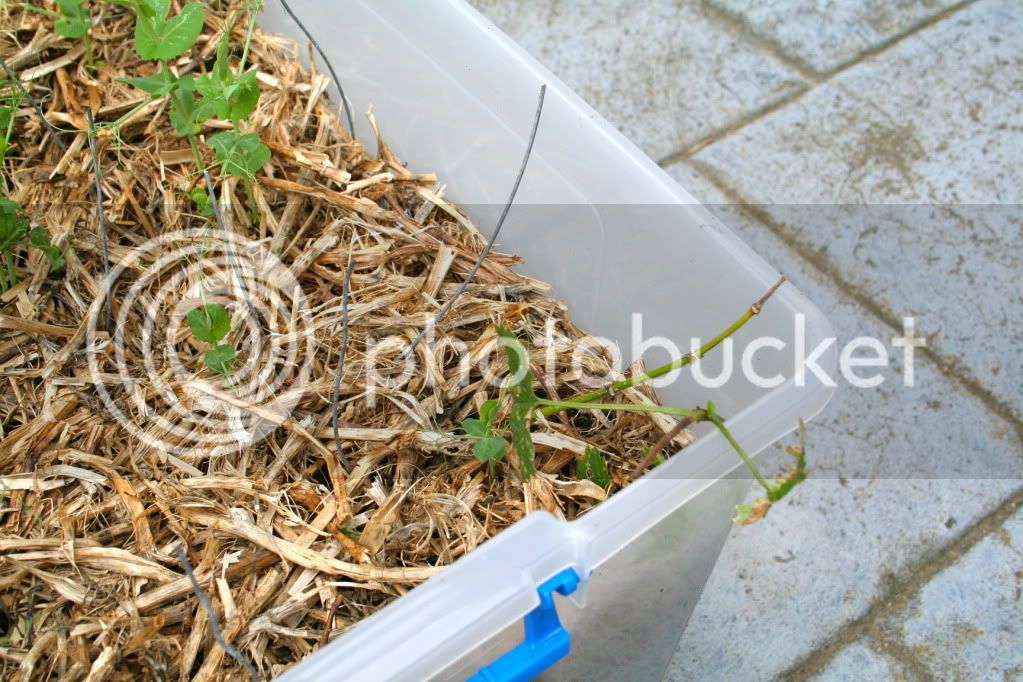
Here we can see two of the hop bines in poor condition with leaf damage, broken off bine growing tips and a chemical signal pulling the energy of the bines back into the rhizome.
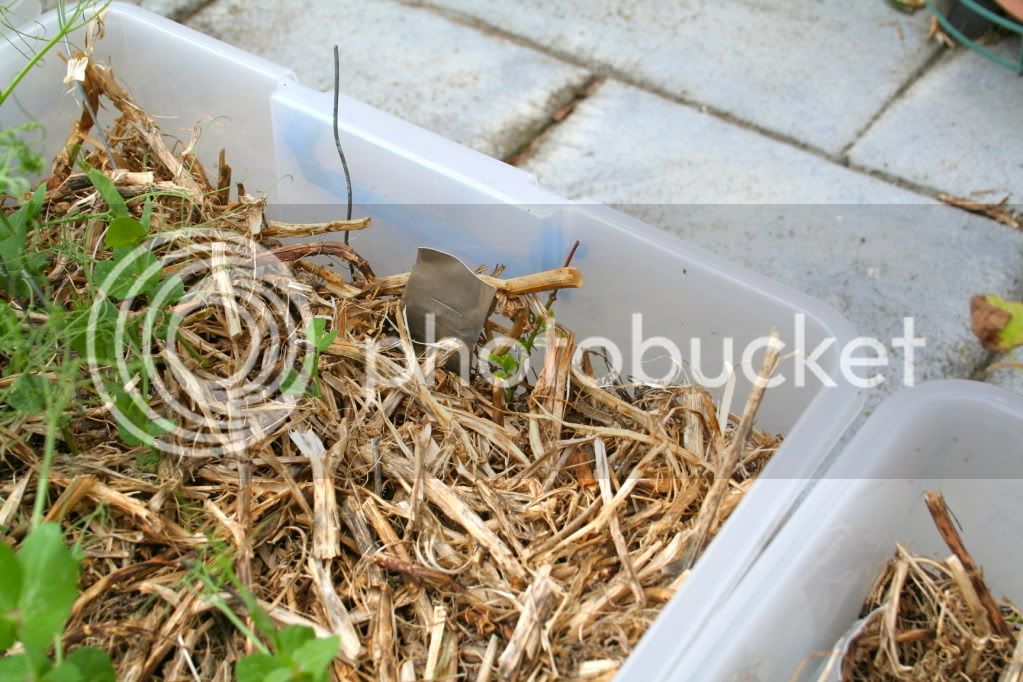
Here we see a Pride of Ringwood bine that was originally pulling back but after being in this system for just over a week has put energy into a side shoot which is emerging and halted the retreat of the entire bine back into the rhizome.
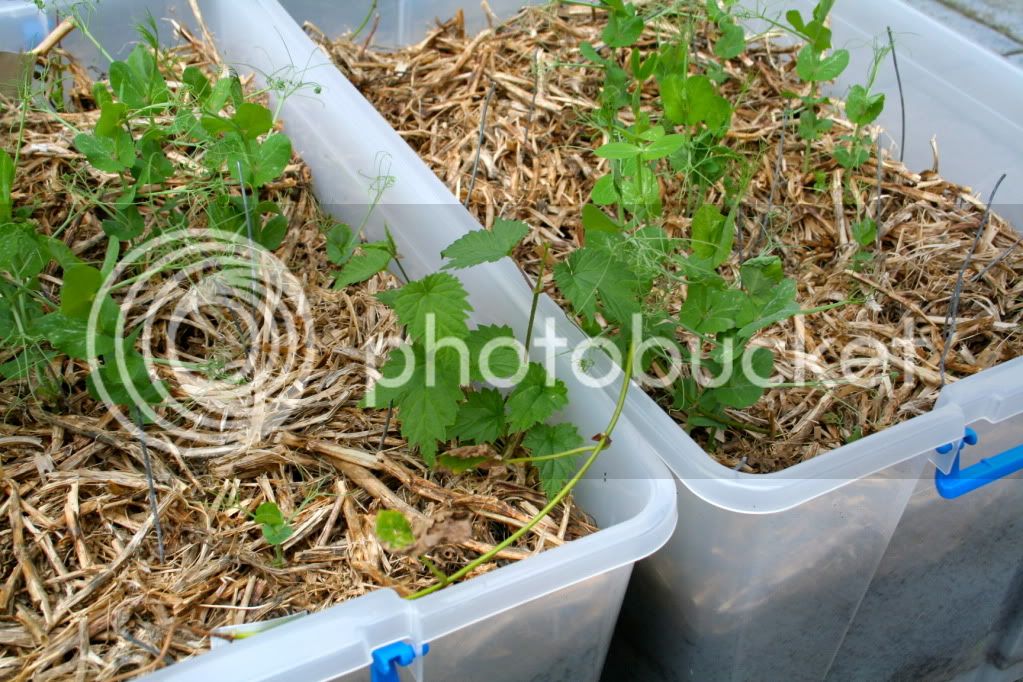
Here we see two Goldings bines.
One is missing the growing tip but had not started receding the bine.
After being placed in the system it shows no sign of receding.
A second bine had broken through the mulch layer and is taking off.
The other receding bine is from a different container.
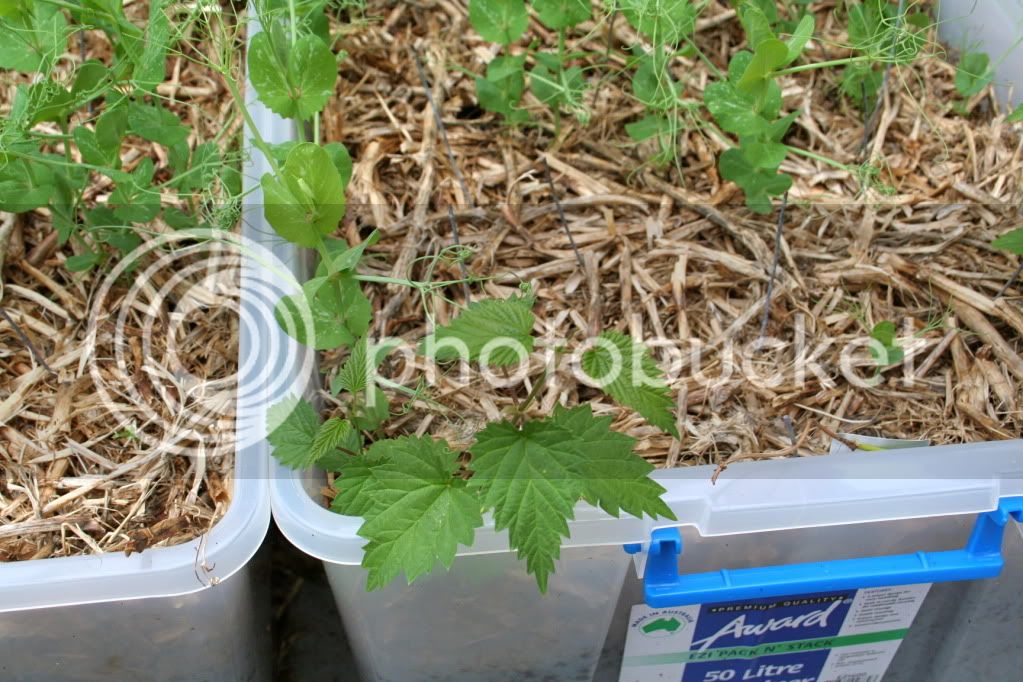
Here we have the same scenario as already mentioned above.
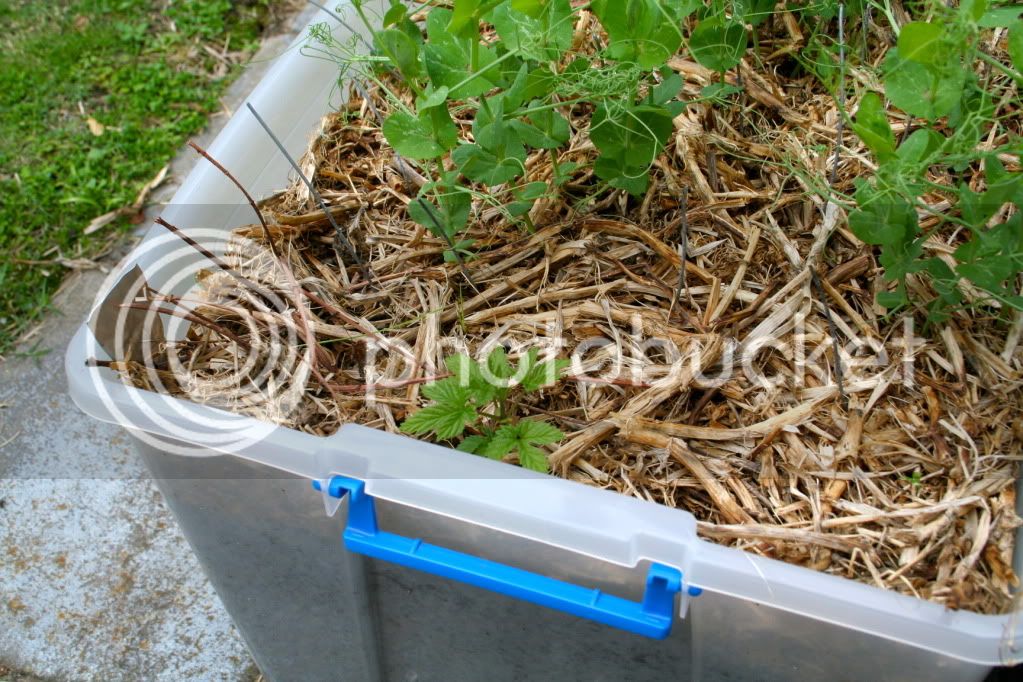
Here we see three Tettnang bines that were gone before planting. All have fully been absorbed back into the rhizome which has thrown off a single bine with full energy bursting through the mulch layer.
All of these hops are in first aid holding pattern until I get their final growing area on the farm prepared for their translplanting.
Cheers,
Brewer Pete

This is the basic setup:
o 50 litre plastic containers from Bunnings on special at $9 each. (including lids - not shown; cheaper to buy than any pot this size)
o A few large bags of good potting mix
o Compressed bale of field pea straw
o Some worm poo tea (not shown)
o Aluminium (optional - name tags)
o Bailing wire or similar (optional - bird deterrent; doves love to steal your straw for nesting material)
Mulch is the single most important thing you can do to ensure that:
o moisture is retained and transpired slowly out of the system
o sunlight does not strike the soil and carbonise off the top soil layer
o there is a carbon/humus system that can be broken down by bacteria and fungi
o weed seeds are retarded in growth (a thicker top layer of mulch required than as shown for this feature)
If I was living in a hot dry bastard of a place like Canberra, I would increase the thickness of the top mulch layer considerably, up to 30cm max thickness which would be overflowing in these containers so adjust size accordingly.

Here we see the layering going on in the containers:
o Small holes punched into the bottom of the containers for drainage (not shown)
o Layer of field pea mulch on the bottom for anaerobic bacterial breakdown cycle
o Middle layer of good potting mix to hold the rhizomes
o A very good layer of field pea straw mulch on top for aerobic bacterial and fungal breakdown cycle (any sprouting peas die and break down releasing nutrients back into the sub soil)
I have allowed the remaining field pea seeds in the top layer mulch to germinated and grow. A symbiotic relationship with nitrogen fixing bacteria in their root nodules will help provide additional plant soluble nitrogen to enter from the air into the potting soil which is not nutrient dense to start with.
Having other plants such as the field pea in the system provides a bait plant to white cabbage moth and other pests to give your hops a chance. Hops by themselves are a primary target for attack. The idea is to confuse and redirect, think of it as Gardening Aikido.
A single application of water diluted worm poo tea was all that was poured on the field pea mulch top layer. This provide a bacterial inoculation tea to help kick start the bacterial cycle.
The lids for each 50 litre container were allowed to rest on top creating a humidity trap and heat trap triggering the pea seeds to germinate faster by fooling them into thinking nice humid spring had arrived. This also kick started the fungal breakdown in the straw and a little more than a week later you can pull apart the top mulch layer and see white cottony fungal mycelium running through the pea straw. The soil to mulch interface layer is lovely and moist and still retaining a healthy soil smell.

Here we can see two of the hop bines in poor condition with leaf damage, broken off bine growing tips and a chemical signal pulling the energy of the bines back into the rhizome.

Here we see a Pride of Ringwood bine that was originally pulling back but after being in this system for just over a week has put energy into a side shoot which is emerging and halted the retreat of the entire bine back into the rhizome.

Here we see two Goldings bines.
One is missing the growing tip but had not started receding the bine.
After being placed in the system it shows no sign of receding.
A second bine had broken through the mulch layer and is taking off.
The other receding bine is from a different container.

Here we have the same scenario as already mentioned above.

Here we see three Tettnang bines that were gone before planting. All have fully been absorbed back into the rhizome which has thrown off a single bine with full energy bursting through the mulch layer.
All of these hops are in first aid holding pattern until I get their final growing area on the farm prepared for their translplanting.
Cheers,
Brewer Pete







